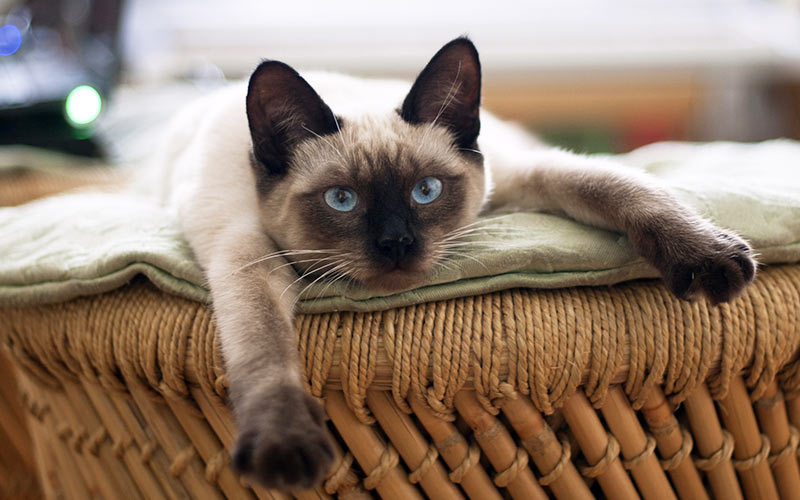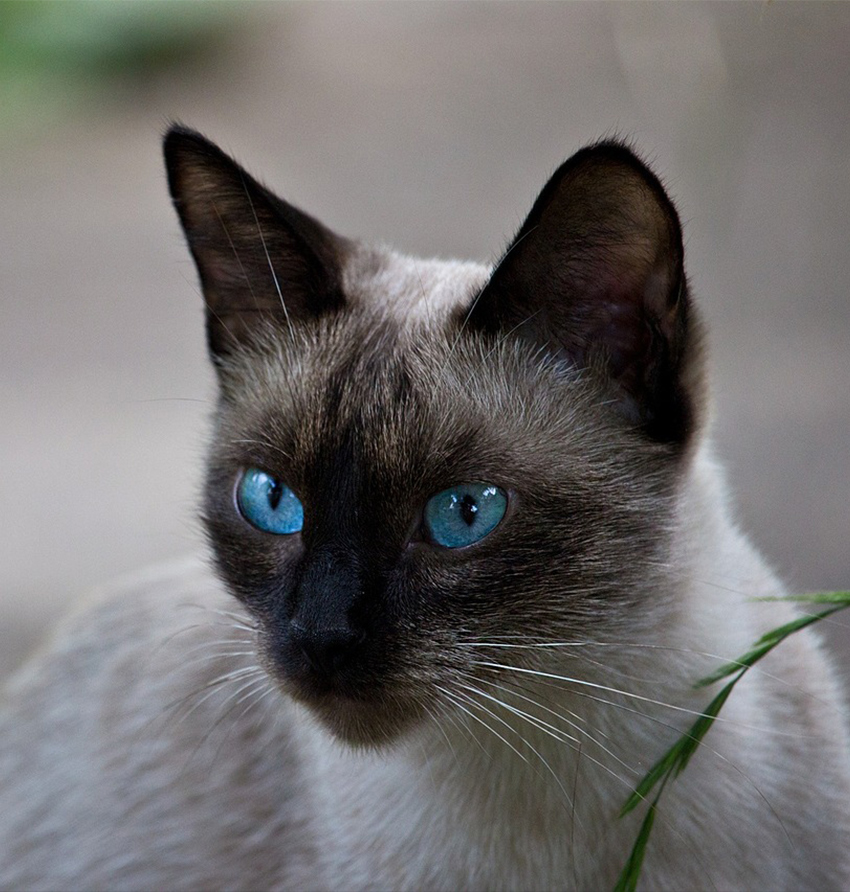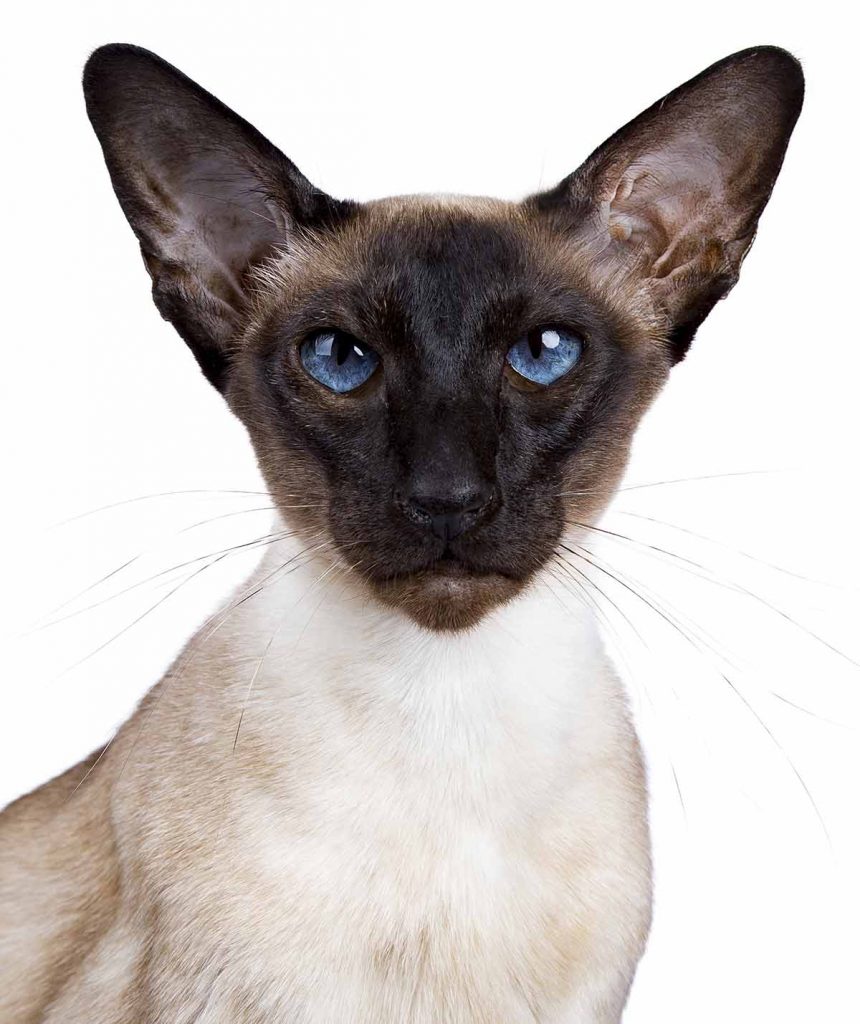
A Siamese wedge head is the current standard for show cats. They are known for a lean, muscular body, long delicate legs and a thin tail. Their unusual name comes from their characteristic wide set ears, sharp face, long muzzle, and extremely slanted blue eyes.
You might be surprised to find that there are different varieties of Siamese cats. They have changed over the years from their origins in Siam, now known as Thailand. One of the most easily recognizable breeds of cat, the Siamese is a distinctive and popular cat. They are all intelligent, loving, and vivacious cats. Their great personality is common to all varieties, but their appearance and health does differ.
Contents
- Meet the different types
- Classic and apple heads
- Modern wedge head Siamese cats
- How looks impact health
When you imagine a Siamese cat, what do you see? Deep dark points, huge ears and big eyes? A narrow muzzle and long slender legs? Whilst these are classic features, they aren’t standard to every member of the breed.
Variations of the Siamese Cat
Over the years, the Siamese cat has undergone a rather drastic change in appearance. This is due to breeding practices and goals set by breeders to meet or exceed show-cat preferences, and hypothetically to eliminate undesirable traits. But who these characteristics are undesirable to and why throws the ethics of the alterations into question.
These days, there are approximately three sub-varieties or types of Siamese cat. These varieties are known as the established “Apple Head”, the typical “Old Style”, and the newer “Wedge Head”.
The Traditional Apple-Head Siamese
This variety is thought to most resemble the original Siamese cats as they were when imported from Thailand.
Traditional Siamese are moderately sized cats, with males reaching as large as 18 pounds. They have a round “apple-shaped” head, with rounder eyes, and a stockier, more muscular body compared to the other varieties.

The Classic Old-Style Siamese
A typical Siamese cat, this type is called “the Classic” by a lot of breeders. They are a mix of the traditional and the modern, and in reality probably a transitional combination of the two extremes.
These cute kitties are sleeker than the traditional, with more slanted eyes and a longer, thinner body. This variety of cat was most popular in the 1950s and 1960s. It is what most people refer to when they think of a Siamese cat.

The Modern Wedge-Head Siamese
Here we have a Siamese cat that is the most modern, and the most exaggerated, version of the breed. As you might be able to guess, it is nicknamed the “Wedge Head Siamese” due to the extreme wedge shape of the cat’s head.

Which Cat Is Friendlier?
The Siamese has a reputation for being an incredibly active and chatty family pet. And although there are reports that they can have a bit of a nasty streak, I’ve met an awful lot of them and I can’t say I’ve ever come across this problem.
Both varieties are loyal and loving, and in fact on occasions rather too demanding of your time and attention. They’ll push and meow at you until they are satisfied they have your full attention, climbing into your lap and sitting on whatever you happen to have been reading beforehand.
The only caveat in terms of temperament is that unwell cats will behave differently to their healthier counterparts. They will be more subdued and may even be grumpy when touched if in pain or struggling to breathe. There have been no studies on the specific impact of this in wedge head Siamese cats at the time of writing, but in my years of experience looking into feline health it’s something to consider.
Colors and Coats
Wedge and apple head Siamese cats are pointed. This means they have dark noses, ears, paws and tails. These points can come in a few different colors, and there isn’t a hard and fast rule that the different types can’t display them all.
Health Concerns for the Modern Wedge Head Siamese Cat
Unfortunately, along with the exaggerated features, the Wedge Head is proving to be more prone to the respiratory and pulmonary problems already associated with the breed.
Breeders are finding that along with a more delicate constitution, the Wedge Head Siamese is prone to dental issues. It is suspected that this is due to the narrower face shape leaving less room for the cat’s teeth to comfortably grow in.
Modern breeders are working to identify the origins and causes of these health issues. Much like the crossed eyes and kinked tail, it is suspected that many of these issues are genetic. There is even a possibility they shorten the cat’s lifetime, but at the moment these reports are purely anecdotal.
Which Type Is The Best Pet?
Because the modern Wedge Head Siamese cat is still so new, there has not yet been any scientific research by the medical community into any health risks. We currently can only speculate and share the observations by breeders and cat owners on the emerging health concerns and issues of this captivating cat.
A Question Of Ethics
I’m often amazed by the way in which people pick a new pet. Overtaken by appearance at the expense of personality or even health. But you can’t blame them on an individual level, it’s a societal trend, and one that finally I can see the door closing on. More and more people who aren’t intimately involved in animal husbandry and breeding practices like I am are having their eyes opened to the ways that our decisions are impacting their cats’ happiness.
As the Siamese cat breed continues to develop, it is possible we will continue to see more changes in appearance. Some maybe for the better! However, for now the safest thing when researching your new pet is to avoid extremes. Healthy felines have a classic cat look, and you can’t go far wrong by sticking with it.

Pictures of the Applehead and Old Style Siamese would have been a useful addition to your article for readers that are not as familiar with the breed. Siamese cats have such a huge variation from breeder to breeder, and each type of Siamese cat has characteristics that make it unique and impact what kind of companion it will be. I have one of each of the three types of Siamese cats you describe, and I know that a lot of Siamese lovers really prefer one type over another because of those traits. For me, their “Siameseyness” makes them amazing friends regardless of their body type. >^..^<
Don’t know what computer system you’re using but I see examples of all three cat face styles shown in the article.
I have two Siamese boys and I knew they were different types but I hadn’t been able to find any information like this so I could identify them.
All I knew is neither is a ‘wedge head’ type and personally I find those quiet unappealing. It does not surprise me that they have health problems, like many animals that are bred to look differently than the would in nature. Shame because they are such sweet cats.
Anyway I’m delighted to find out that I have both a ‘classic’ and ‘traditional’.
My younger boy is stocky and has much more rounded features. The other is long and skinny and his muzzle does come to a point, but not in the exaggerated way of the show cats. Both have the big blue eyes and dark markings.
I wonder is there any type specific variations in markings that someone could look out for, or are they always unique to each cat?
My traditional cat has stripes running up his head I wondered if that is more typical of the apple head type.
Thanks for the informative article!
I had a wedge head, Suki, who just died this past spring. Very needy little bugger, but loved him so much. Takes some getting used to the head shape, but he was very handsome and pranced like a fawn. He was adorable. I inherited him from a neighbor. Anyway, he lived to be close to 17 years old. I did have to have his teeth removed because of the horrible dental problems the little guy had, but he was a happy camper after that. I also had a russian blue that I lost to ear cancer which is unheard of, but she was even smarter than Suki. I absolutely adored her–Gracie. Tiny little thing with pale peridot eyes. When I had Suki I also had a big orange male, Boonie, who Suki followed around like a little brother. I miss them all. I was surprised to read here the life span of the wedge head siamese and can attest that they do live much longer than 4-6 years!
Actually Suki looked exactly like the very first picture at the top, and he would lie there with the same relaxed eyes and just observe. My sister always had apple head siamese and they were always fairly aloof. Not Suki. They are very affectionate and must be with you at all times.
Aww so sorry for your loss of Suki, he sounds great. My baby is a mix of traditional and classic, more classic I think. He looks like the thai cats a bit too but more delicate and elongated. He has perfect lines and proportions. To me that is the quintessential siamese cats 🙂
Sleeping Cat a poem
sleep cat
sleep comrade, rest, the day is long when you’re in the sun
for you know not what comes your way
meow meow meow is how they go
and to this, so you know.
I’m looking for a classic Siamese. Live in Washington state. Is there any out there around here?
There are a few refutable Siamese and Balinese apple heads (Long haired Siamese) breeders in every state. The Balinese is an incredible Cat, rated the most intelligent of all felines. I have both myself, once you have a Bali, you will NEVER want any other breed ever again. They are that special, their life expectancy is only second to the Burmese. A healthy Bali will live 20+ years. They have the most beautiful coats, with the bluest Sapphire eyes you have ever seen in your life. They are work though, very busy cats always into something. I used to trip over my Bali 5 times a day, he was always in my feet. They are VERY affectionate. I love my Siamese boy, but my Balinese is in a completely different league. Do yourself a favor, go research Apple head Balinese cats or kittens. I promise you this cat is at Top in the Cattery world.